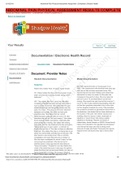Summary
FULL SUMMARY 'Organization Theory & Design' - Daft, Murphy & Willmott.
- Course
- Institution
- Book
Full summary of all 14 chapters of 'Organization Theory & Design' by Richard L. Daft, Jonathan Murphy and Hugh Willmott. Many tables and images are used to clarify the text.
[Show more]








